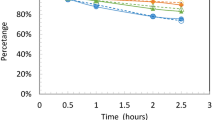Abstract
Sorghum fibers were pretreated with ammonium hydroxide and the effectiveness of the pretreatment evaluated by enzyme hydrolysis and ethanol production. The treatment was carried out by mixing sorghum fibers, ammonia, and water at a ratio of 1:0.14:8 at 160°C for 1 h under 140–160 psi pressure. Approximately 44% lignin and 35% hemicellulose were removed during the process. Untreated and dilute-ammonia-treated fibers at 10% dry solids were hydrolyzed using combinations of commercially available enzymes, Spezyme CP and Novozyme 188. Enzyme combinations were tested at full strength (60 FPU Spezyme CP and 64 CBU Novozyme 188/g glucan) and at half strength (30 FPU Spezyme CP and 32 CBU Novozyme 188/g glucan). Biomass enzyme hydrolysis was conducted for 24 h. Saccharomyces cerevisiae D5A was added post hydrolysis for conversion of glucose to ethanol. Theoretical cellulose yields for treated biomass were 84% and 73%, and hemicellulose yields were 73% and 55% for full strength and half strength, respectively. Average cellulose yield was 38% and hemicellulose yield was 14.5% for untreated biomass. Ethanol yields were 25 g/100 g dry biomass and 21 g/100 g dry biomass for full strength and half strength enzyme concentrations, respectively. Controls averaged 10 g ethanol/100 g dry biomass.



Similar content being viewed by others
References
US DOE (2006) Breaking the cellulosic barriers of cellulosic ethanol: a joint research agenda. Available online: http://www.biomatnet.org/publications/2098rep.pdf
Zhang YHP (2008) Reviving the carbohydrate economy via multi-product lignocelluloses biorefineries. J Ind Microbiol Biotechnol 35:367–375
Hamelinck CN, van Hooijdonk G, Faaij APC (2005) Ethanol from lignocellulosic biomass: techno-economic performance in short-, middle- and long-term. Biomass Bioenerg 28:384–410
Taherzadeh MJ, Karimi K (2007) Acid-based hydrolysis processes for ethanol from lignocellulosic materials: a review. Bioresources 2(3):472–499
Mosier N, Wyman C, Dale B, Elander R, Lee YY, Holtzapple M, Ladisch M (2005) Features of promising technologies for pretreatment of lignocellulosic biomass. Bioresour Technol 96(6):673–686
Liu Z, Saha B, Slininger P (2008) Lignocellulosic biomass conversion to ethanol by Saccharomyces. In: Wall J, Harwood C, Demain A (eds) Bioenergy. ASM Press, Washington, DC, pp 17–36
Wyman CE, Dale BE, Elander RT, Holtzapple M, Ladisch MR, Lee YY (2005) Comparative sugar recovery data from laboratory scale application of leading pretreatment technologies to corn stover. Bioresour Technol 96(18):2026–2032
Oh KK, Kim YS, Yoon HH, Tae BS (2002) Pretreatment of lignocellulosic biomass using combination of ammonia recycled percolation and dilute-acid process. J Ind Eng Chem 8(1):64–70
Yoon HH (1998) Pretreatment of lignocellulosic biomass by autohydrolysis and aqueous ammonia percolation. Korean J Chem Eng 15(6):631–636
Holtzapple MT, Lundeen JE, Sturgis R, Lewis JE, Dale BE (1992) Pretreatment of lignocellulosic municipal solid waste by ammonia fiber explosion (AFEX). Appl Biochem Biotechnol 34–35(1):5–21
Kim TH, Kim JS, Sunwoo C, Lee YY (2003) Pretreatment of corn stover by aqueous ammonia. Bioresour Technol 90:39–47
Kim TH, Lee YY (2005) Pretreatment of corn stover by soaking in aqueous ammonia. Appl Biochem Biotechnol 121–124:1119–1131
Kim TH, Lee YY (2006) Fractionation of corn stover by hot-water and aqueous ammonia treatment. Bioresour Technol 97:224–232
Kim TH, Lee YY (2007) Pretreatment of corn stover by soaking in aqueous ammonia at moderate temperatures. Appl Biochem Biotechnol 136–140:81–92
Kim TH, Taylor F, Hicks KB (2008) Bioethanol production from barley hull using SAA (soaking in aqueous ammonia) pretreatment. Bioresour Technol 99:5694–5702
Mamma D, Christakopoulos P, Koullas D, Kekos D, Macris BJ, Kouki E (1995) An alternative approach to the bioconversion of sweet sorghum carbohydrates to ethanol. Biomass Bioenerg 8(2):99–103
Gnansounou E, Dauriat A, Wyman CE (2005) Refining sweet sorghum to ethanol and sugar: economic trade-offs in the context of North China. Bioresour Technol 96:985–1002
Chang VS, Holtzapple MT (2000) Fundamental factors affecting biomass enzymatic reactivity. Appl Biochem Biotechnol 84–86:5–37
Palmqvist E, Hahn-Hägerdal B (2000) Fermentation of lignocellulosic hydrolysates. II: inhibitors and mechanism of inhibition. Bioresour Technol 74:25–33
Sun Y, Cheng J (2002) Hydrolysis of lignocellulosic materials for ethanol production: a review. Bioresour Technol 83:1–11
Tolan JS (2006) Iogen’s demonstration process for producing ethanol from cellulosic biomass. In: Kamm B, Gruber PR, Kamm M (eds) Biorefineries—industrial processes and products: status quo and future directions, vol 1. Wiley, Weigheim, pp 193–208
Kurakake M, Kisaka W, Ouchi K, Komaki T (2001) Pretreatment with ammonia water for enzymatic hydrolysis of corn husk, bagasse, and switchgrass. Appl Biochem Biotechnol 90(3):251–259
Gibbons WR, Westby CA, Dobbs TL (1986) Intermediate-scale, semicontinuous solid-phase fermentation process for production of fuel ethanol from sweet sorghum. Appl Environ Microbiol 51(1):115–122
Ban J, Yu J, Zhang X, Tan T (2008) Ethanol production from sweet sorghum residual. Front Chem Eng China 2(4):452–455
Mamma D, Koullas D, Fountoukidis G, Kekos D, Macris BJ, Koukios E (1995) Bioethanol from sweet sorghum: simultaneous saccharification and fermentation of carbohydrates by a mixed microbial culture. Process Biochem 31(4):377–381
Yu J, Zhang X, Tan T (2008) Ethanol production by solid state fermentation of sweet sorghum using thermotolerant yeast strain. Fuel Process Technol 89(11):1056–1059
Maiorella B, Blanch HW, Wilke CR (1983) By-product inhibition effects on ethanolic fermentation by Saccharomyces cerevisiae. Biotechnol Bioeng 25(1):103–121
Acknowledgments
The authors would like to thank the US Department of Energy (Award# DE-FG36-08GO88151) for their financial support of this research project. The authors would also like to thank Dr. Lee Madsen and Chardcie Verret from the Audubon Sugar Institute at Louisiana State University AgCenter for their analytical support and Margaret C. Henk from the Department of Biological Sciences at Louisiana State University for SEM sample preparation.
Author information
Authors and Affiliations
Corresponding author
Rights and permissions
About this article
Cite this article
Salvi, D.A., Aita, G.M., Robert, D. et al. Ethanol production from sorghum by a dilute ammonia pretreatment. J Ind Microbiol Biotechnol 37, 27–34 (2010). https://doi.org/10.1007/s10295-009-0645-5
Received:
Accepted:
Published:
Issue Date:
DOI: https://doi.org/10.1007/s10295-009-0645-5




